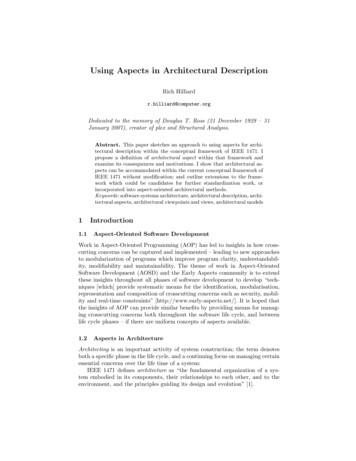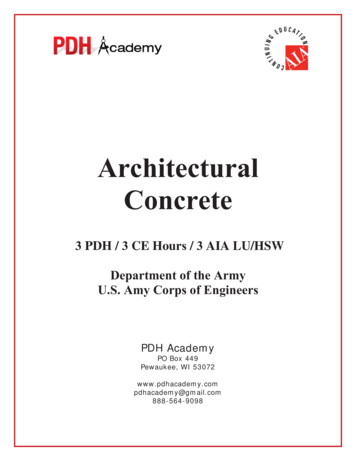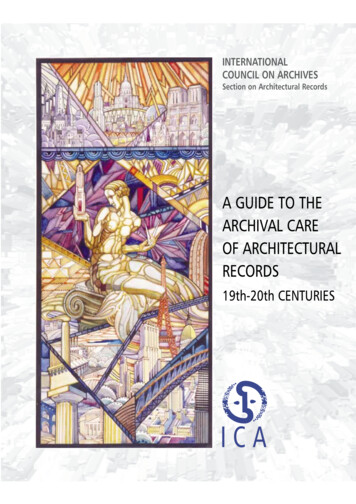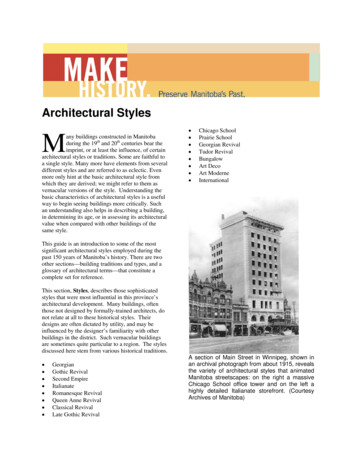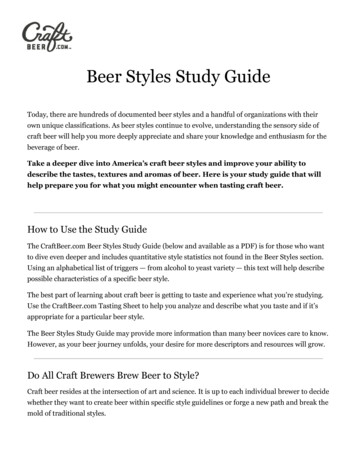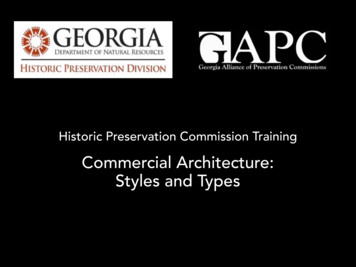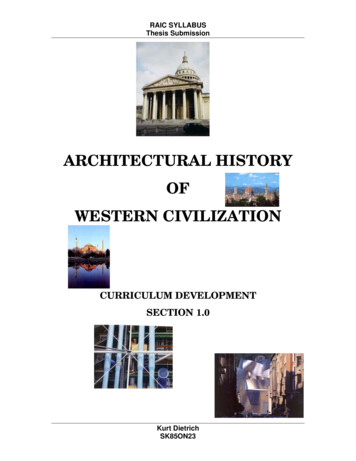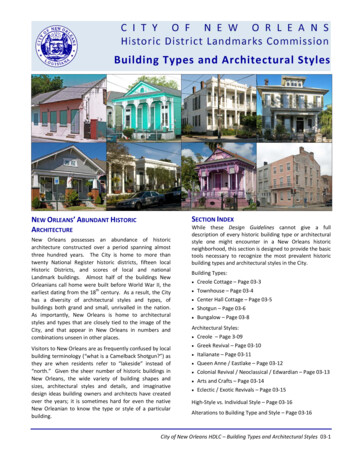
Transcription
Building Types and Architectural StylesSECTION INDEXNEW ORLEANS’ ABUNDANT HISTORICARCHITECTURENew Orleans possesses an abundance of historicarchitecture constructed over a period spanning almostthree hundred years. The City is home to more thantwenty National Register historic districts, fifteen localHistoric Districts, and scores of local and nationalLandmark buildings. Almost half of the buildings NewOrleanians call home were built before World War II, theearliest dating from the 18th century. As a result, the Cityhas a diversity of architectural styles and types, ofbuildings both grand and small, unrivalled in the nation.As importantly, New Orleans is home to architecturalstyles and types that are closely tied to the image of theCity, and that appear in New Orleans in numbers andcombinations unseen in other places.Visitors to New Orleans are as frequently confused by localbuilding terminology (“what is a Camelback Shotgun?”) asthey are when residents refer to “lakeside” instead of“north.” Given the sheer number of historic buildings inNew Orleans, the wide variety of building shapes andsizes, architectural styles and details, and imaginativedesign ideas building owners and architects have createdover the years; it is sometimes hard for even the nativeNew Orleanian to know the type or style of a particularbuilding.While these Design Guidelines cannot give a fulldescription of every historic building type or architecturalstyle one might encounter in a New Orleans historicneighborhood, this section is designed to provide the basictools necessary to recognize the most prevalent historicbuilding types and architectural styles in the City.Building Types: Creole Cottage – Page 03‐3 Townhouse – Page 03‐4 Center Hall Cottage – Page 03‐5 Shotgun – Page 03‐6 Bungalow – Page 03‐8Architectural Styles: Creole – Page 3‐09 Greek Revival – Page 03‐10 Italianate – Page 03‐11 Queen Anne / Eastlake – Page 03‐12 Colonial Revival / Neoclassical / Edwardian – Page 03‐13 Arts and Crafts – Page 03‐14 Eclectic / Exotic Revivals – Page 03‐15High‐Style vs. Individual Style – Page 03‐16Alterations to Building Type and Style – Page 03‐16City of New Orleans HDLC – Building Types and Architectural Styles 03‐1
“BUILDING TYPES” AND “ARCHITECTURALSTYLES”Building type refers to the basic “bones” of the buildingsuch as: Is it long and narrow, 1 story tall, 1 room wide? Taller than it is wide, with no roof to speak of anddouble galleries?Architectural style refers to the more decorative buildingelements: What do the porch columns or brackets look like? Does it have plain siding or is there a pattern? Does it look like a wedding cake or a Greek temple?When a building type like a Shotgun is combined withelements of an architectural style, such as Greek Revivalwith classical columns and a wide porch, the final productis a Greek Revival Shotgun, which contains the bones ofone and the styling of the other.It is important to keep in mind that some building typesare closely associated with some styles, such as Bungalowsand Arts and Crafts. By contrast, some combinationsalmost never happen, for example a Creole Cottage withEastlake detailing.Similar to clothing fashion, the popularity of building stylesand types change over time, and in some cases, types fellout of fashion before certain styles, and vice versa.This Townhouse building type is in the Greek revival style.Some of the character‐defining elements include thedouble gallery supported by classically inspired piers ancolumns, a stepped pediment, the Greek key surround atthe front entrance door, and the wood siding “scored” toresemble stone blocks.HOW TYPES AND STYLES WERE SELECTED FOR THISSECTIONShotguns were often “decorated” with Eastlake styleembellishments.There are a wide range of buildings in New Orleans’historic neighborhoods. The types and styles in thissection are those that occur most and whose descriptionwill be most useful to the typical property owner in a localHistoric District. As a result, some styles and types havebeen left out entirely. If a specific property does not seemto fit any of the styles or types described in this section,please consult the books and other resources on NewOrleans architecture that are referenced on Page 01‐14 ofthe Guidelines Introduction, on the HDLC websitewww.nola.gov, or contact the HDLC Staff at (504) 658‐7040 for assistance.03‐2 City of New Orleans HDLC – Building Types and Architectural Styles
BUILDING TYPESThe façade of this Creole Cottage is symmetrical and thebuilding is topped by a steeply pitched side gabled roofwith an abat‐vent extension.This weatherboard Creole Cottage has a steeply pitchedside gable roof that extends over the front façade toprovide rain protection over the windows and doors.CREOLE COTTAGE(1790S‐1870S)The Creole Cottage is the earliest remaining local housing type in the City of NewOrleans. It is a vernacular type – typically designed and built by the owners andbuilders to fit local needs – and heavily influenced by both French and Spanishconstruction methods and the local climate. The typical Creole Cottage is 1‐ to 1½‐stories tall, 2 rooms wide and 2 rooms deep, often with small storage rooms(cabinets) attached at the rear to each side. Creole Cottages have hipped or sidegabled roofs, frequently with tall, narrow gabled dormer windows.A typical Creole Cottage façade is symmetrical with four openings, usually four setsof French doors or two sets of French doors and two double hung windows, allshuttered. Smaller Creole Cottages 1 room wide by 2 rooms deep, with only onedoor and a window (a “2‐bay cottage”) also occur, although less frequently. Thefront façade is typically sheltered from the weather by an overhang (abat‐vent)that directs rain away from the front façade and windows. Earlier Creole Cottagesare typically of brick between posts or masonry construction with smooth plasteror wood weatherboard sheathing. Later Creole Cottages are often of frameconstruction with wood weatherboard siding.While the Creole Cottage is a vernacular type with minimal stylistic features,cottages built at different times may exhibit subtle stylistic details of their period,such as arched or flat‐topped windows, dentil moldings, and “Greek Key” doorsurrounds. In some cases, Italianate details were added to update older cottages.City of New Orleans HDLC – Building Types and Architectural Styles 03‐3
The main block of this Townhouse features a side gableroof. Townhouses typically include multi‐level servicewings accessed by exterior galleries.Townhouses with galleries on each floor stretching the fullwidth of the façade are typically referred to as DoubleGalleries.TOWNHOUSE(1790S‐1890S)The Townhouse building type, or some variation thereof, is a very common type inurban areas, because its vertical massing and long, narrow footprint makesefficient use of land. The townhouse in New Orleans appeared first in its Creoleform in the late colonial period, but the basic type remained popular for the betterpart of a century and has recently seen a resurgence in popularity.The Townhouse building type is a 2‐ to 3‐story, 2 room deep building withdistinctly vertical massing, a side gabled or hipped roof, and a long, narrowfootprint oriented to the street. The “Creole Townhouse” typically has acarriageway instead of an entrance door and no interior first floor hallway. The“American Townhouse” has a grand front entrance door leading to an interiorhallway. A Townhouse with galleries on each floor stretching the full width of thefaçade is typically referred to as a “Double Gallery.” Despite their grandappearance from the street, Townhouses usually have relatively few formal rooms,often with a smaller service wing behind.In Townhouses of different periods of construction, the type and style of windowswill vary, as will its placement on the lot as well as whether or not projections suchas balconies or galleries are present.03‐4 City of New Orleans HDLC – Building Types and Architectural Styles
The side gable roof form, central door flanked by windowsand deep front porch are typical features of a Center HallCottage.This raised Center Hall Cottage is spanned by a deep frontporch.CENTER HALL COTTAGE(1830S‐1880S)The Center Hall Cottage is a vernacular building type that is common throughoutthe American South and the Caribbean. Its origins no doubt predate its use in NewOrleans, where it began to occur in its typical raised form in the 1830s and ‘40s.The Center Hall has a rectangular plan, typically at least 2 rooms wide and 2 deepwith a central hallway running from the front façade to the rear, and 2 smallstorage rooms (cabinets) to either side on the rear, flanking a rear service porch.Center Hall Cottages have side gabled roofs, often with dormer windows. Thefront façade of the typical Center Hall is spanned by a deep front porch covered bya flat roof supported by symmetrically placed columns and accessed by a centralstair. It has a symmetrical arrangement of windows, usually two to either side ofthe front entry door. Center Hall Cottages are most frequently sheathed in woodweatherboard, although the exact type will vary according to style. A variant ofthe Center Hall Cottage is the Raised Center Hall Cottage, typically raised on piersto five feet or more above grade.Greek Revival and Italianate Center Hall Cottages are most common in NewOrleans, but the type can be found in other styles including Queen Anne/Eastlakeand other Victorian styles.City of New Orleans HDLC – Building Types and Architectural Styles 03‐5
This narrow single Shotgun includes a paired, shuttered,door and window with a front gabled roof and a hippedprojecting overhang.The form of this residence is typical of a double Shotgunwith a central pair of windows flanked by entrance doors.SHOTGUN(1830S‐1950S)The earliest known examples of Shotgun type houses in New Orleans date at leastto the 1830s. Shotgun houses bear a strong resemblance to Caribbean housetypes prevalent in the 18th century, and some historians suggest it may have beenimported to New Orleans in the early 19th century. Whatever its origins, this highlyefficient and comparatively inexpensive building type was so popular among boththe middle and working classes for over a century that it is probably the mostprevalent historic building type in the city.The simplest Shotgun type house is the “single Shotgun,” a long narrow structure 1room wide and 3 to 5 rooms deep, with each room opening onto the next. Inaddition to the Shotgun single, the Shotgun type includes “Shotgun doubles,”“Camelback Shotguns,” “Sidehall Shotguns,” and “Side Gallery Shotguns.”The typical Shotgun single façade consists of a door and window, usuallyshuttered, which may or may not feature a porch or deep overhang to offerprotection from the weather. The typical Shotgun has a front gabled or hippedroof.The Shotgun double is essentially a twinned single, a 2‐unit residence with asymmetrical façade of two doors and windows, each unit 1 room wide and 3 to 5rooms deep with no interior hallway. Shotgun doubles usually have a front roof03‐6 City of New Orleans HDLC – Building Types and Architectural Styles
This Camelback Shotgun double has a deeply overhanginghipped roof over the main block and a side gable rearsecond story addition.This Side Gallery Shotgun features a narrow covered sideporch at the right that acts as an exterior corridor toconnect the rooms.overhang and may or may not have a front porch providing shelter from theelements.The Camelback Shotgun is essentially a Shotgun single or a Shotgun double, with asecond story rising at the rear portion of the building. The second story originatedas a vertical addition to increase living space, but was later built as a part of theoriginal house.The Sidehall Cottage and Side Gallery Shotguns are very similar in form. Theirfront façades usually are 3 bays wide with two windows and a front door. Similarto Shotguns, they are each 1 room wide and 3 to 6 rooms deep. Unlike Shotguns,both Sidehall and Side Gallery Shotguns include a passageway that runs most ofthe length of the house. The difference between the Sidehall Cottage and SideGallery Shotgun types is that the side passage in a Sidehall Cottage is aconventional hallway, while in the Side Gallery Shotgun it is a narrow covered sideporch. A hybrid of these two types can be found in which the front door opensonto a side hall 1 room deep, and then onto a side gallery.Shotgun type buildings can be found with façade decorations, windows and doors,and front porch designs reflecting every architectural style popular in New Orleansfrom 1830‐1950. In addition, there are many humbler, purely utilitarian Shotguntype buildings that have little to no stylistic embellishment.City of New Orleans HDLC – Building Types and Architectural Styles 03‐7
The prominent shed roof dormer with multiple windows,extended eaves, and deep front porch are typical of aBungalow.This Bungalow features intersecting roofs withoverhanging eaves as well as a deep porch.BUNGALOW(1910S‐1950S)The basic Bungalow typology probably originated in India, Indonesia, or the SouthPacific and was imported to Britain in the 19th century by Britons who had lived inthose areas. The Bungalow type did not become popular in the United States untiljust after 1900, when it was strongly associated with the Arts and Crafts orCraftsman style. The Bungalow type achieved its greatest early popularity andstylistic development in California. The Bungalow type began to appear in NewOrleans after the First World War, and continued in popularity until at least the1950s.The basic Bungalow is a 1‐ to 1½‐story residence, usually about as wide as it isdeep, with a moderately irregular floor plan, reflecting the internal roomarrangement and sometimes incorporating bay window projections. Buildings inthe Bungalow type almost invariably have a substantial front porch that may beincorporated under the main roof or project in front of the main roof structure.Bungalow‐type residences are usually asymmetrical in composition, with complexroof plans, including gable on hip, cross‐gabled, or more complex plans, frequentlywith substantial dormer windows.The Bungalow type is typically found in the Arts and Crafts style, but may alsoshow motifs of other early 20th century architectural styles, such as the ColonialRevival.03‐8 City of New Orleans HDLC – Building Types and Architectural Styles
ARCHITECTURAL STYLESThis simple stucco box has deep overhangs at the eaves.Windows and doors are understated and protected byshutters with strap hinges.CREOLECreole townhouses often include a carriage way as seen onthe left instead of a prominent entrance door. The secondfloor gallery was a later addition.(1800S‐1840S)The Creole style, while often thought of as a “French Colonial” style, in fact is anarchitectural style developed in New Orleans. It represents a melding of theFrench, Spanish and Caribbean architectural influences in conjunction with thedemands of the hot, humid climate of New Orleans. As the aesthetics of Americanarchitecture were accepted within the Creole population, the style died out infavor of more fashionable styles.Hallmarks of the Creole style include simplicity, brick, stucco or weatherboardexterior walls, large six over six windows, French doors, no dominant entrancesand shutters attached with strap hinges on all windows and doors. In 2‐storyCreole townhouses or mixed use buildings, fanlights above ground floor windowsoften open to provide ventilation and can provide illumination to an entresol ormezzanine. Unroofed second floor galleries with wrought iron railings were oftenadded after 1850.It is unusual to find buildings where the Creole style is liberally mixed with anotherarchitectural style. Most frequently, one might find a Creole style building that hasbeen modified by placing Italianate brackets under galleries or roof overhangs.City of New Orleans HDLC – Building Types and Architectural Styles 03‐9
This Greek Revival residence has a pedimented portico withdouble‐height round columns flanked by boxed cornerpiers.This double gallery is supported by fluted Ionic columnswhich are more delicate in appearance than the squareposts typically associated with Greek Revival buildings.GREEK REVIVALth(1820S‐1860S)thDuring the 18 and early 19 centuries, in both the newly formed United Statesand in Europe, the architecture and arts of the classical world were adopted assymbols of democracy. The Greek Revival style is strongly associated in thepopular mind with the southern United States, although it is a style that appearedthroughout the country.Hallmark elements of the style as it appears in New Orleans include wide, flat,plain, often “Greek key” design or pedimented trim around windows and doorsand full height porches with classical round columns or boxed piers. Roofs may befront gabled or hipped, and porches may be topped with triangular, flat, orstepped pediments and/or wide, plain entablatures, often with dentil molding.Building finishes are usually plain in style, and frequently the primary cladding isstucco or wood scored to look like stone blocks. Originally, these may have beenpainted in two colors to make them more closely resemble classical masonry.The Greek Revival style is often associated with mansions, plantation houses andinstitutional or commercial buildings, but it was also popular on more modestresidences, such as Cottages and Shotguns of all types.03‐10 City of New Orleans HDLC – Building Types and Architectural Styles
This bracketed shotgun house has Italianate bracketssupporting the deep front overhang above.The posts supporting the double gallery have archedbrackets and a deep horizontal overhang, typical of theItalianate style.ITALIANATE(1850S‐1880S)thThe Italianate style is a 19 century interpretation of the architectural motifs ofItalian Renaissance and Northern Italian vernacular architecture. The style waspopular in England and the American East Coast beginning in the 1840s, and tookhold in New Orleans in the 1850s. It was a very popular style during the 1860s and1870s, and some of its elements appeared in a mixture with other styles until atleast 1900.Common characteristics of the Italianate style include tall, double hung, four‐over‐four, two‐over‐two or two‐over‐one windows with arched heads and hoodmoldings, symmetrical facades, hipped roofs, frequently hidden behind a parapet.Italianate‐style buildings have horizontally protruding eaves visually supported bybrackets, single or paired. Cladding on primary facades is usually weatherboard orwood drop butt siding, often with weatherboard on secondary facades. Cornersare typically marked by molded or carved quoins, typically small raised blocksmounted on a flat board.Elements of the Italianate style can be found mixed with other, later styles, moststrikingly in the large number of “bracketed” shotgun type houses. This verypopular hybrid style usually features oversized carved or turned wood bracketssupporting a deep front overhang, Italianate window forms, drop siding, carvedquoins, and Queen Anne “gingerbread” embellishment.City of New Orleans HDLC – Building Types and Architectural Styles 03‐11
This Queen Anne home has a distinctive roof line withmultiple dormers and a corner turret.This shotgun has applied Queen Anne / Eastlake “brackets”at the porch columns that frame the span to appear like aseries of arches.QUEEN ANNE / EASTLAKE(1870S‐1900S)The related Queen Anne and Eastlake styles came into vogue in New Orleans inthe late 1870s and continued to be influential until the first decade of the 20thcentury. These styles were wildly popular across the United States, spreadthrough the use of commonly available architectural pattern books and madepossible by new mechanized woodworking techniques that made highly ornateembellishment fairly inexpensive. Elements of both styles are similar and oftenintermixed.The most striking feature of Queen Anne and Eastlake styles is usually the use ofpierced, cut, turned, and other patterned wooden trim, quoins, brackets, porchposts and rails, often in conjunction with wooden shingle siding in a variety ofshapes and patterns. High‐style Queen Anne and Eastlake style buildingsfrequently sport wrap‐around porches, irregular floor plans, complex roof plans,bay windows, turrets or towers, patterned roofing shingles, decorative metal ridgecaps and attic vents, and multi‐light, specialty‐shaped or stained glass windows.New Orleans has many examples of high‐style Queen Anne and Eastlake stylebuildings, but this number is dwarfed by the profusion of shotgun‐type dwellingsdecorated with Queen Anne or Eastlake style elements. The use of the styles onshotguns ranges from modest turned wood brackets to porches and front façadesthat are highly embellished with decorative woodwork.03‐12 City of New Orleans HDLC – Building Types and Architectural Styles
Neoclassical buildings often feature classically inspireddetails such as fluted porch columns, ornate cornices andpediments.The double‐hung window features a decorative multi‐lightupper sash with classically inspired surround.COLONIAL REVIVAL/NEOCLASSICAL REVIVAL/EDWARDIAN(1870S‐1930S)The Colonial Revival and Neoclassical Revival styles both owe their initial popularityto international expositions, the Colonial Revival to the Centennial Exposition of1876 in Philadelphia and the Neoclassical to the 1893 Columbian Exposition inChicago. Each represents a resurgence of interest in architectural styles associatedwith the symmetrical, classically‐based architecture popular in the 18th century.Edwardian style refers to design that became popular between 1890 and 1920whose primary distinguishing characteristics are a relative simplicity of form anddetail, often embellished with elements of Colonial or Neoclassical Revival detail.The Colonial Revival style includes stylistic motifs that include classical pilasters, sixover six double hung windows, egg and dart and dentil moldings, porchessupported by classical columns, and doors flanked by sidelights and topped withfanlights. Neoclassical Revival buildings tend to be more ornate than ColonialRevival, with fluted columns topped by complex capitals, friezes and entablaturesembellished with garlanded or patterned carvings and massive porticos. Edwardianstyle homes tend to be simple rectangles in plan, 1‐ to 2‐stories in height, with afront or cross gabled roof and subdued decorative elements.Colonial and Neoclassical Revival stylistic motifs can frequently be found mixed withearlier Victorian styles and sometimes with later styles, like Arts and Crafts, and onshotgun type residences.City of New Orleans HDLC – Building Types and Architectural Styles 03‐13
This high‐style Arts and Crafts home features exposedrafter tails and fascia boards, various wood siding finishesand deep porches and overhangs.This double shotgun has Arts and Crafts stylistic elementsincluding deep overhanging eaves with decorative fasciaboards.ARTS AND CRAFTS(1900S‐1940S)The Arts and Crafts style in New Orleans is a combination of influences from theCalifornia Craftsman style, the English Arts and Crafts style, and the Prairie‐stylebungalows of the Mid‐West. Early examples of the style arrived in New Orleansaround 1900, but it was most popular in the 1920s and 1930s. Common designthemes of the style include: the use of unadorned structural building parts, such asrafter tails, fascia boards, and roof and porch beams as decorative elements; theuse of “natural” or “rustic” materials such as wood shingle siding and eitherroughhewn masonry or rusticated concrete block, often in combination; and thepresence of deep porches, with robust porch columns and overhanging eaves.In addition to these design elements, high‐style Arts and Crafts residencesfrequently have irregular bungalow floor plans; rectilinear window bays; heavy,horizontal massing; windows composed of many small patterned panes and/orleaded glass windows; and, frequently, oversized windows under the porchoverhang. They may also be raised a half story above grade, with a masonry orstucco foundation wall.Arts and Crafts shotguns are also fairly common in New Orleans. Typically, onthese structures the style is expressed through doors and windows with square orrectangular panes or patterns, plain shingles or wood cladding and tapered woodporch columns, usually with masonry bases.03‐14 City of New Orleans HDLC – Building Types and Architectural Styles
This home is inspired by a Mediterranean villa and includesa hipped terra cotta roof, stucco walls and vertical archedwindow and door openings.This corner tower feature has a pyramidal hipped roofcovered with red terra cotta tiles. The textured stuccowalls are framed by smooth “quoins”.ECLECTIC / EXOTIC REVIVALS(1900S‐1950S)Beginning in the 1920s, popular architecture began to take forms loosely adaptedfrom real or imagined historical forms. A variety of homes were built whosedesign drew inspiration from popular conceptions of Italian villas, Renaissancepalaces, medieval English cottages, Gothic Revival church buildings, SpanishMission architecture and many other picturesque architectural styles.Assorted “Revival” styles can be found in New Orleans commercial andinstitutional architecture, as well as numerous homes. Homes in these stylesranged in scale from the palatial to very small starter homes, but the majority of“Revival” style homes were built for the middle class. The materials and motifsused in these styles were often scaled down from the original inspiration, so aMission Revival cottage might feature a faux bell tower, a Norman Revivalfarmhouse reduced to 1,000 sq. ft., or a Renaissance palazzo translated to a onestory, 1,200 sq. ft. foot home.As time went by, these styles became even less faithful to their inspirations, andthe motifs associated with them began to be the only expression of the style. So,for example, a building that was essentially a smooth‐stuccoed rectangular boxcould become a Spanish Colonial Revival home with the addition of a Spanish tileroof, wrought iron window grilles, and an arched entryway, or pay homage to aRenaissance palazzo by adding twisted columns to window and door surrounds.City of New Orleans HDLC – Building Types and Architectural Styles 03‐15
HIGH STYLE VERSUS INDIVIDUAL STYLEAs owners modify their properties to reflect their personaltastes, it is not at all uncommon to see a building thatincludes more than one style. When any given buildingwas designed, its owners worked with a builder orarchitect to create a structure that reflected both theirneeds and tastes, not one that fulfilled a checklist titled“Creole Cottage” or “Greek Revival Townhouse.” Somebuildings were designed by architects and others bybuilders, owners and commercially available plans.Individuals may have preferred pure Greek Revival forms,while others may have wanted a copy of a house they sawvisiting California or on the Mediterranean Coast, with aporch just like one they saw on a house that morning, thewindows from another and the roof of a third.If a building seems to have all of the elements listed hereunder “Creole Cottage” but it has 5 openings on the frontfaçade instead of 2 or 4, it is most likely an unusual CreoleCottage and not some other style or type of buildingentirely. If a building appears to have both Greek Revivaland Italianate details, it is probably just that one style waswaning in popularity, as another was becoming morefashionable, and the person who built it thought theylooked nice together. Just because one building is acombination of two or three styles, another has all thecharacteristics of a style, and a third is a building with nostyle to speak of does not mean that one of them is anymore “historic” or important than the other. Our City’sunmistakable architectural character is attained throughnot only its diversity of building types and styles, but alsoeach building’s relationship to those around it.This home features Italianate style elements at the 2ndfloor and neoclassical elements, such as the porch columnsand frieze, at the 1st floor.ALTERATIONS TO BUILDING TYPES AND STYLESAt properties where modifications have been made overtime, those changes, particularly those made before themid‐20th century, may have become significant character‐defining features of its development. By contrast, morerecent changes, particularly those with inappropriatematerials or details, often compromise historic integrity.When considering alterations to a historic property,identifying the building type and style is a critical first stepin ensuring a successful result. Simply stated: The HDLC encourages the removal of inappropriate laterchanges to make buildings and properties morehistorically appropriate.The HDLC discourages modern changes that furthercompromise a building’s or property’s historic type,style, significance and integrity.INFORMATION ABOUT APPROPRIATE ALTERATIONSIf considering altering a building and would like moreinformation regarding whether the proposed change isappropriate for the building type or style, pleasecontact the HDLC at (504) 658‐7040 for moreinformation.This material is based upon work assisted by a grant from the Department of the Interior, National Park Service. Any opinions, findings, andconclusions or recommendations expressed in this material are those of the authors and do not necessarily reflect the views of theDepartment of the Interior. Prepared by Dominique M. Hawkins, AIA, LEED AP of Preservation Design Partnership, LLC in Philadelphia, PA, and Catherine E. Barrier.Building type drawings are largely based on Lloyd Vogt’s New Orleans Architecture: A House Watcher’s Guide.03‐16 City of New Orleans HDLC – Building Types and Architectural StylesMay 2011
New Orleans, the wide variety of building shapes and sizes, architectural styles and details, and imaginative design ideas building owners and architects have created over the years; it is sometimes hard for even the native New Orleanian to know the type or style of a particular building.


